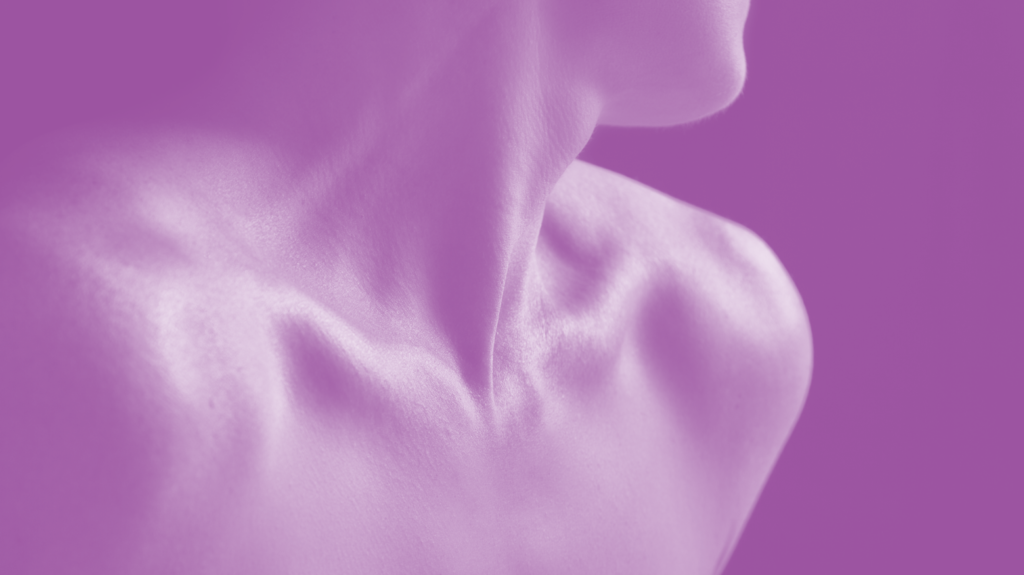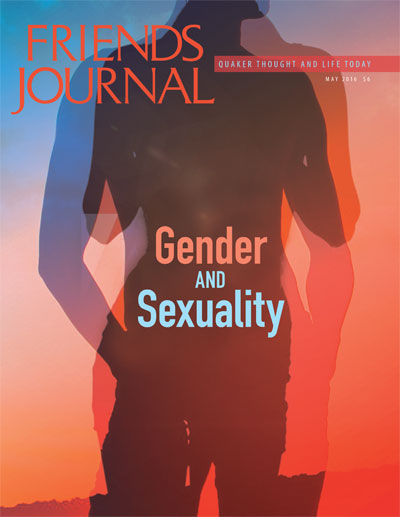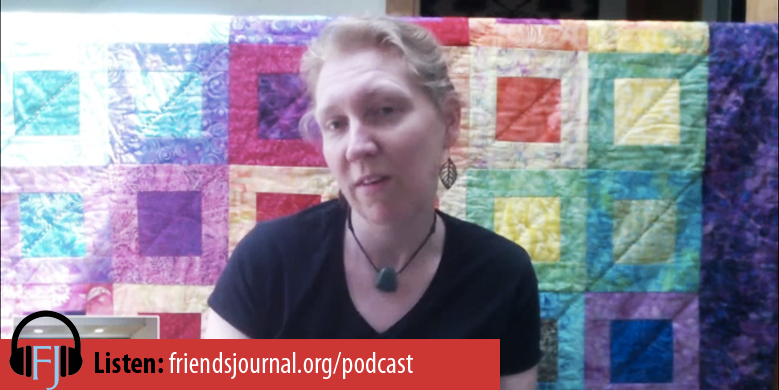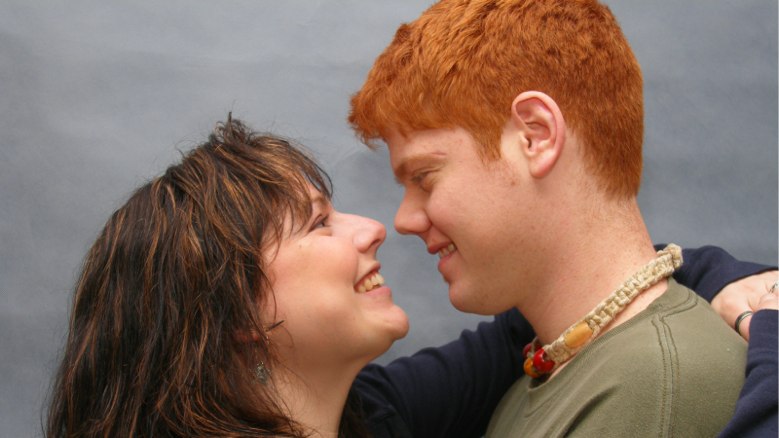
I’ve been a sexuality teacher for over 15 years and a human being for 41 years, and I can confidently say that when it comes to gender, sexuality, and our bodies, there is no normal. When I tell the creation story to my six-year-old child (I tell the first one in the Bible, not the second, more popular one), I explain that each of us represents some aspect of God and that only through looking at and celebrating the full diversity of humanity can we begin to understand the full scope and complexity of God. Society, even our Quaker Society, puts so many limits on us that we can easily forget that there is no normal and that stepping into our truest selves is an act of worship that brings the Divine into our everyday lives. For some of us, being our truest selves is much easier and safer than it is for others of us.
The language we use to talk about our gender, sexuality, and bodies is useful when it can clarify, claim, and help understand identity; it is damaging and harmful when it is used to negate, box-in, or deny identity and lived reality. I want to offer readers two things in this article: (1) a framework and some language for understanding the relationship between and the differences of our gender, sexuality, and bodies; and (2) an exposure to the vast and varied ways that we can each claim and name who we are.
Let’s start with our bodies, the physical vessels that house our spirits and are the target of a lot of societal messaging and expectations. Our bodies show up in all different ways. At birth, almost all of us are assigned a gender based on a quick, visual inspection of our genitals. For every 100 births, 48 of us are assigned female, having only a visible vulva; 51 of us are assigned male, having only a visible penis and testes; and one of us, at birth or later in life, is assigned intersex, having parts or chromosomes that exist in an array of combinations that exceed either the narrow margins of XX (and what we generally think of as typical “female” reproductive anatomy) or XY (and what we generally think of as typical “male” reproductive anatomy). I put “female” and “male” in quotations here, as I know men with the same reproductive anatomy that I have. (I’ve conceived with my own egg and given birth to a child, so you can figure out what parts I have.) Our current English language is not yet able to accurately describe our millennia-old human reality.
These gender assignments have huge implications for how we will be treated and what will be expected of us. Sometimes we find an affinity of experience with others who have the same assignment, and sometimes we don’t. My sister—the person with whom I share the same genetic origin, upbringing, experiences, choices, and interests—and I experience our bodies very differently. We have more in common in our nature and nurture than either of us has with any other person on the planet. Yet if you were to ask each of us five questions about our relationship to our bodies or how being in our own bodies has shaped our lives, you would get fundamentally different answers.
Both my sister and I understand ourselves to be women, and so our assignment of “female” at birth was not diminishing or traumatic, as it can be for many who are misgendered in their initial assignment or at times throughout their lives. As one female Friend wrote, “I was almost always misgendered as a child (assigned male). I consider it a form of abuse and not something to be public about. If I ever really heal from that, maybe I’ll be out, but for now it is too dangerous.”
I’m cisgender: my gender—who I know myself to be—and my assignment line up. Friends of mine whose gender is not recognized by the assignment someone else gave them use lots of different words to describe this aspect of themselves: trans, transgender, transsexual, genderqueer, gender-non-binary, and more. Each of these words has a different meaning, connotation, and nuance. Some people do not participate in or experience gender at all, and may use “agender” to describe this aspect of their identity or reality.
Those of us who are not agender have a gender identity (who we know ourselves to be) and a gender expression (gender markers we show to the world with our dress, mannerisms, and body presentation). Our gender identity may be static for our whole lives, or our understanding of it might shift and flow as we live. Our gender expression might be an authentic presentation of our gender identity; it might be what is safe, acceptable, available, or functional for the place in which we live; or our expression might be some combination of the two.
While it is natural to be curious about another human being, all we can ever say to others about their bodies or gender expression is, “You look awesome!” The only question that is appropriate to ask others about their bodies is, “How are you doing?” (When entering into a sexual or physically intimate relationship with someone, it is appropriate to discuss boundaries, likes, how our bodies function, and safety.) Imagine what would shift if the only commentary we got about our bodies and gender expression was “You look awesome!” Because, you do look awesome; you manifest a unique aspect of God that no one else on the planet does. That is awesome.
There are so many words to describe and claim identity. Even though I work in the field and teach in an urban school (the locus of much new language), I am not able to keep up on all the new ways of talking about the human experience. I do follow these basic rules that keep me in good stead:
- I regularly read and listen to people whose identities are different from mine.
- I listen intently to the language people use when talking about themselves, and I use that language respectfully.
- I ask what words mean when I don’t know. I don’t ask people to share personal information or expect them to share their story for my benefit.
- If I am not sure, I ask if it is acceptable for me to use a word, and I check the power dynamics behind it.
- I am gentle with myself and work to make amends when my ignorance harms others.
Just as our bodies get gendered early on and our current mainstream language is limited, so too is our language for sexuality gendered and limited. Often sexuality and sexual orientation are used interchangeably, but they are different. Sexuality, for those of us who are not asexual, encompasses sensuality—what we find erotic, how we experience pleasure and desire, what turns us on and gets us off, and more. Sexuality is about how I can and do enjoy my physical body, my emotional self, and my romantic self—with or without sharing myself with someone else. For most of us, our sexuality exists whether or not we are sexually active. Like gender, our sexuality may be fairly static for our lives or it may shift and flow in different ways at different times in our lives. Our experience of our sexuality can be deeply influenced by our environment, health, social circles, experiences of sexual violence or violation, aging, faith, culture, and more.
Sexual orientation is a small piece of this larger sphere of sexuality. Sexual orientation describes who we are interested in sharing our sexuality with. The most common words used to describe sexual orientation—gay, lesbian, bi, straight—connote both one’s own gender and the gender of the kinds of people to whom they are generally attracted. I am generally attracted to some other women so call myself a “lesbian.” I often say “gay” and even more frequently these days use “queer.” I use all three words interchangeably for myself and use a specific one depending where I am. I like the female space of lesbian; I welcome anyone who tells me that is their space, too. I like the movement aspect of gay. I claim queer to just be me and to stand with the huge array of people for whom cis and/or hetero is just not who we are. I am conscious that all these words mean different things to other people who also use them.
When I do workshops about our bodies, gender, and sexuality, I share the above visual to help illustrate how I understand these aspects of our human divinity to exist. In a workshop, I ask people to add the words and terms they use or have heard used to describe our physical bodies, our gender identities and expressions, and our sexualities and sexual orientations. Find a f/Friend and fill in the words for yourself that best celebrate your experience and reality.
I reached out to a wide group of Friends and asked each of them to share a list of one to three words to describe their physical body, gender, sexuality, sexual orientation, and anything else they wanted to say about their identity. Here is what I received back, a window into the divine diversity of how we show up and experience our humanity.
Dan
Physical body: strikingly average, white, early 40s
I’ve always been bemused to think my (gay) sexual orientation has a lot to do with my gender and my body, and yet, the reality is that I’m almost frighteningly average for a white guy: height, weight, activity level, hairiness, etc.
Gender: comfortably, playfully male
Sexuality: ecstatic, joyful, fundamental
Sexual orientation: gay, queer
I think it’s important that we acknowledge that there’s a difference in intensity to how people respond to sexuality. It’s (at times surprisingly to me!) core to my life but less so for others.
I also wish when we talked about sexuality in the context of spirituality, we could talk about two things: (1) the amazing gift that is desire, and (2) how sexuality often pushes us out of our comfort zone: we find ourselves attracted to people we don’t know from different communities or classes, and we take risks for sex.
Nicole
Physical body: finally female
Gender: a woman
When a larger reason exists to justify being public about my gender history, I will describe myself as a transsexual woman, and occasionally as a transgender woman or transwoman.
Sexuality: 65-year-old virgin
Sexual orientation: Questioning, but no one is answering!
Shadow
Physical body: tall, 40s, European
Gender: female
I used to dress up and present as male because of childhood trauma, but then I changed to present more honestly as myself.
Sexuality: private
Sexual orientation: lesbian
Sara
Physical body: hot, changing, strong
I am proud of my body, and grateful for the gifts it brings me. I consider it one of my core political and spiritual commitments to actively reject negative messages about it, no matter their source.
Gender: I love being a woman, and I love that name. I welcome all who want to share it!
Sexuality: hot, changing, strong
Sexual orientation: straight, heterosexual
I’m comfortable with the language I learned during my early adult years, but I love the spaces people are opening up with new words and forms of self-naming.
Jed
Physical body: tall, skinny, huggable
I was assigned female at birth, and I view my body as male.
Gender: trans masculine, femme, faggy
Sexuality: queer
Sexual orientation: none
I am primarily attracted to cis and trans men.
Will
Physical body: tall, bearded
My skeletal structure and my facial hair mean that, no matter what I wear or do, most other people will classify me as a man the instant they meet me. I like these things about me: the style of my beard reminds me of my commitment to nonviolence, and it’s often useful to be tall. But I don’t like the experience of being “manned” by others, and at times have found it distressing and disorienting enough to interfere with healthy functioning.
Gender: agender, transgender
I’m cautious about using “transgender” for myself because there are a number of different ways it’s used today. Some definitions include me and some don’t, and I’ve seen both types of definition serve useful purposes.
Sexuality and sexual orientation: polyamorous, queer, bisexual
“Queer” feels more like home than any other word because I’ve had that word for the longest, as my understanding of gender and sexuality has grown and shifted, and as I’ve changed. Though the word feels clinical to me, it’s important to me to claim the word bisexual. I’m part of a history of bisexual activism and community-building that has sometimes been ignored or minimized.
QSJ
Physical body: curvy, muscular or strong, smooth.
I’ve had to work very hard on positive language about my body, as others describe me as “big” or “overweight.” I’m very active and strong, and that is never reflected in the language others use.
Gender: “Femme” or “queer femme”
I use these as nouns, though most often dropping the article. For example, I would say “I’m femme,” rather than “I am a femme.” However, I use this self-descriptor almost exclusively in queer community where I am sure to be understood.
Being femme is not just about femininity or feminine presentation. It’s also about strength. The most concise definition of “femme” is to be strong and feminine.
Sexuality: I don’t usually describe my sexuality. I usually describe my sexual orientation and/or gender identity.
Sexual orientation: I usually say “gay” rather than “queer” with straight people or in company that I don’t know. Using “queer” feels too personal, as, for me, that includes my gender expression, even though it is quite physically obvious.
Robb
Physical body: temple, magnificent, galaxy
Gender: unsure, in the middle, repressed
Sexuality: shame, energy, love
Sexual orientation: gay, men, penis
Rachel
Physical body: hairy, female, muscular
Gender: androgynous, feral, female, trans spirit, two spirited
Sexuality: powerful, erratic, phases, light under a bushel
When I discovered my own fabulous orgasms around age nine, I thought I had discovered a great and wonderful secret that others did not know about.
Sexual orientation: on the spectrum but not always in the same place on the spectrum, usually lesbian
Polly
Physical body: temporarily able-bodied, butchy female, white, aging, changing
Gender: cis-gendered woman/female
In some contexts I speak of gender as butch, butchy woman, mildly gender-bending/playful (and aware of privilege I have as cisgendered woman to go here without any real risk/danger).
Sexuality: lesbian, queer
Sexual orientation: lesbian, gay/gay woman, queer
Joe
Physical body: strong, aging, Caucasian
Gender: male, stereotyped, privileged
I have never felt like a “man’s man,” which for me brings up stereotyped images of someone who does not show emotion, is stoic, and mechanically adept. I have never fit that description and was criticized by men as being a “cry baby.” It was not until middle age that I began to feel more comfortable in my own skin and happy being who I am. The words “strong man” now have a much richer, broader, and deeper meaning for me.
Sexuality: aging, diminished, significant
Sexual orientation: hetero, clear, privileged
Prudence
Physical body: slim, pretty, often sick
Gender: I identify as female and as a woman. I present as mostly feminine.
Sexuality: I am figuring out my sexuality. Flirting and sex with men is usually about power, where I’m trying to outdo them somehow. Flirting and sex with women is more emotional and connective.
Sexual orientation: I identify as polyamorous. I kind of identify as queer and bisexual but feel outside of queer culture. I identified as straight and monogamous for most of my life.
Debbie
I had the most amazing (for me) reaction to your questions, which was to realize that, in fact, I don’t think much or talk about any of it. I just don’t. I think of my body as strong, healthy, and also soft. As far as gender and sexuality, it’s just not a topic that comes up for me.
Annie
Physical body: female
Gender: female, cis-gendered, femme (as a noun)
Not sure “femme” quite fits here, but it’s a big part of who I am, and it seems to fit better here than elsewhere. I use “femme” as a noun rather than as an adjective, because I mean I’m someone who’s attracted to butches. I do tend towards more feminine presentation, but I don’t wear heels or have long painted nails or shave my legs. I work in a traditionally male field and often end up wearing grubby jeans and hardhat and steel-toed boots at work.
Sexuality: queer
Since my spouse has figured out she’s genderqueer or possibly trans, “lesbian” and “gay” no longer seem to fit. I don’t feel straight, however, and don’t want to deny my history in the lesbian community; “queer” gives me a way to acknowledge all that.
Daniel
Physical body: lithe, muscular, happy
All my body descriptions have changed over the time of my transition (FtM) from negative to positive.
Gender: guy, man, male
Sexuality: vibrant, healthy, delightful
Sexual orientation: My orientation is labeled “Attractive Live Adult Human Being,” or ALAHB.
Alice
Physical body: healthy, young, top heavy
As a young woman, it’s hard for me to think of terms that aren’t related to sexiness/attractiveness ratings.
Gender: woman
As a woman of about 30, I am currently feeling the intensity of the divide between the woman-who’s-a-mother and the woman-who-has-no-kids as the way many people think about womanhood.
Sexuality: changes with mood
Sexual orientation: attracted to men
I’m not sure I have language to describe the aspects of my sexuality other than sexual orientation or level of sex drive.








Comments on Friendsjournal.org may be used in the Forum of the print magazine and may be edited for length and clarity.